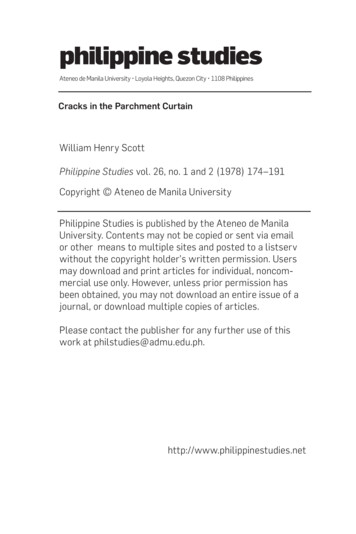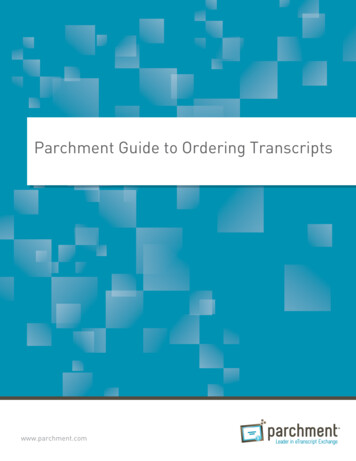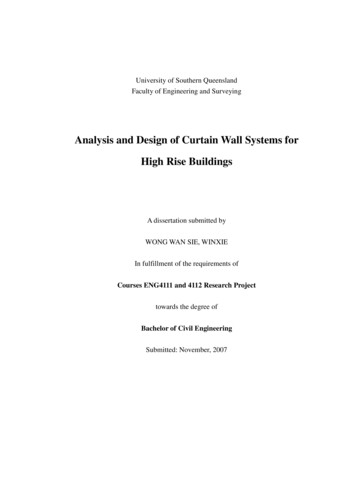
Transcription
philippine studiesAteneo de Manila University Loyola Heights, Quezon City 1108 PhilippinesCracks in the Parchment CurtainWilliam Henry ScottPhilippine Studies vol. 26, no. 1 and 2 (1978) 174–191Copyright Ateneo de Manila UniversityPhilippine Studies is published by the Ateneo de ManilaUniversity. Contents may not be copied or sent via emailor other means to multiple sites and posted to a listservwithout the copyright holder’s written permission. Usersmay download and print articles for individual, noncommercial use only. However, unless prior permission hasbeen obtained, you may not download an entire issue of ajournal, or download multiple copies of articles.Please contact the publisher for any further use of thiswork at es.net
Philippine Studies 26(1978):174-91Cracks in the Parchment CurtainWILLIAM HENRYSCOTTThe terms "iron curtain" and "bamboo curtain" have becomepopular in the English-language press to signify the state control ofinformation in the Soviet Union and the People's Republic ofChina which makes it difficult or impossible for outsiders to learnthe true condition of their citizens' circumstances. Just so we mightspeak of a "parchment curtain" to signify the official documents ofthe Spanish colonial regime which prevent the modern Filipinofrom forming a clear picture of his ancestors' conditions. It is theexistence of this parchment curtain that moved Filipino historianTeodoro A. Agoncillo to his well-taken comment that it will neverbe possible to write a real history of the Filipino people underSpain because the colonial government enjoyed a monopoly on theproduction of source materials.Yet there are cracks in that curtain, chinks, so to speak, throughwhich fleeting glimpses of Filipinos and their reactions to Spanishdominion may be seen. These are more often than not unintentional and merely incidental to the purpose of the documentscontaining them. Original letters and reports, bickering complaintsamong conquistadores, appeals for support, reward, and promotion, long-winded recommendations that were neverimplemented, and decrees inspired by local obstruction of government goals - all these contain direct or implied references toFilipino behavior and conditions. These insights do not generallyappear in the official histories which are based on the documents.The author of a history book has the task of setting forth the endresults of the events surveyed and so does not have time to cite suchdetails as do not illustrate his point. Yet every researcher inSpanish or Philippine archives quickly learns that almost anydocument contains some little Filipino glimpse for which he wasnot looking and which did not interest the author of the document.
CRACKS IN PARCHMENT CURTAIN175A few examples will show just how interesting, or even significant,such details may be.In 1971, I was searching for references to Juan de Salcedo in theArchives of the Indies in Seville. I was writing a book on the historyof Spanish contacts with the Igorots of northern Luzon and washoping to verify a tantalizing hint in Gaspar de San Agustin's 1698Conquistas that Salcedo had discovered the Igorot gold mines. Theproblem was that the Conquistas was published 120 years afterSalcedo's death and there were very few contemporary referencesto him in other sources. Happily, I was able to locate his hojas deservicios, or "service record."These hojas de servicios are collections of sworn testimonies to aman's service to the King which would justify some personalreward or pension from the state. In Salcedo's case, the occasionwas an appeal for pension on the part of his widowed mother, herclaims being not only her son's services but those of his conquistador father, Pedro, in Mexico. The procedure was for a notarypublic to swear in a number of witnesses and ask each of them aseries of set questions about the actual deeds of the personinvolved. The Salcedo testimonies run to three inches of pages, ofwhich the following is a fair sample: "To the sixth question he saidthat what he knows about it is that after making the said journeycontained in the preceding question, the said Juan de Salcedobegged and supplicated the said Adelantado that he give himlicense to go to explore this island of Luzon throughout the northern regions, and the said Adelantado pointed out to him thedifficulty of not having the ships for him to sail in, and the aforesaidthen offered to look for them himself at his own expense; and so hewent and this witness saw him set forth from the City of Manila forthe islands of Baco, Mindoro and Balayan and those nearby them,and after some time he returned to this city with eight or nine fullymanned native boats; and, with license and instructions from thesaid Adelantado, he went to explore the opposite coast of thisisland of Luzon, and after many days came back overland throughthe Lakes of Manila; and after his and his soldiers' return, thiswitness learned how he had circumnavigated 200 leagues of coastand discovered the provinces of Pangasinan, Ilocos and Cagayan,and that it is a land rich with much gold; and that in the said journeyhe and his comrades suffered many hardships and risked their livesby making war against the natives because they were many and
176PHILIPPINE STUDIESarmed and fortified with artillery, besides which they tried to givethem poison in their food and drink to kill them; so when hereturned, he brought information, and gave testimony before ascribe, of the towns and provinces which he had reduced to peace,which were given out as encomiendas by the Governor, who at thattime was Guido de Lavezares, because when he arrived the saidAdelantado was dead; and in this he gave special service to HisMajesty inasmuch as it seems to be a rich land from which muchgold has been secured and is expected to increase; and when hecame, he brought as tributes he had collected for His Majesty, agreat quantity of gold which he turned over to the Royal Treasury;and this he knows of this question, and it is public knowledge andwell known, etc."'This testimony, like those of the other witnesses, is disappointing as far as the Igorot gold mines are concerned. But it is veryrevealing of Filipino reactions to conquest north of Manila, andmay well explain the paradox of Juan de Salcedo's reputationin written accounts. On the one hand, he is remembered for hisability to ingratiate himself with surrendenng Filipinos -and viceversa -but, on the other, he was the object of strong criticism byAugustinian eye-witness Fray Martin de Rada for the excessiveviolence and bloodshed of the northern expedition. Perhaps thevigor of the Filipino defense of their homes, coming especiallyafter the willingness of others to capitulate, touched off conquistador fury as it was to do in the Island of Samar during Americanconquest 325 years later. Especially interesting is the reference toartillerfa which is made by most of the witnesses, and even more sothe word arcabuces which appears in one of the testimonies: "Inthe said journey and exploration, he passed through many hardships, wars, hunger, and deprivations, and was observed to havereally risked his life both by sea, sailing along the said oppositecoast which is rough, and by land among many enemies who tookup arms against him and gave attack, generally with arquebuses,poisoned arrows, spears, and other offensive hand arms."*By artillerfa we are presumably to understand such weaponry asthe well-known Moro lantakas, but by arcabuces some sort ofhandguns must be meant, if not actual arquebuses - that is,1. Archivo General de Indias, Seccibn Patronato, 75, No. 2, ramo 2. (See Appendix Afor text.)2. Ibid.
CRACKS IN PARCHMENT CURTAIN177large-bore, unrifled muskets ignited by matchlocks. Publishedaccounts establish the presence of such firearms in Muslimcontrolled areas of the Philippines- e.g., the 1613 San Buenaventura Tagalog dictionary definesastingal as "Arquebus, of the kindthey used to use in olden times in their wars and which came fromBorneo" - but this appears to be the first reference to them innorthern Luzon. Of course, both Chinese and Japanese tradersand corsairs, who were armed with such weapons, were frequenting the area in Juan de Salcedo's day, so there is no reason whyFilipinos should not have had firearms there, too. History's silenceabout them may simply reflect the fact that they were not important enough to the overall story of conquest and conversion to beworthy of mention.During the same period of research, I made a copy of thenotarized document of 18 April 1571, which formalized Legazpi'soccupation of Manila with the legal niceties of which Hapsburgimperialists were so fond. I was interested in the document becauseof one of Jost Rizal's comments in his annotated edition ofMorga's Sucesos: "The term 'conquest' cannot be applied to morethan a few islands and only in a very broad sense. Cebu, Panay,Luzon, Mindoro, etc., cannot be called conquered. It was accomplished by means of pacts, peace treaties, and reciprocal alliance ." Despite due respect for Dr. Rizal, I doubted that treaties dictated by victors to vanquished would, either then or later, be reallyreciprocal. Moreover, I suspected that they would betray theirfarcical nature by representing the conquered as not only willingbut happy to accept defeat. The 1571 document did not disappointthis expectation."IN THE RIVER and town of Manilaof the island of Luzon of thePhilippines of His Majesty's Islands of the West, on the eighteenthday of the month of May of 1572 [sic], before the very illustriousSeiior Miguel L6pez de Legazpi, His Majesty's Governor andCaptain General of the people and fleet of the discovery of theWest, in my presence, Fernando Riquel, senior notary, and theGovernor's, and Father Fray Diego de Herrera, Provincial of theOrder of San Agustin, being present, and Maestre-de-CampoMartin de Goiti, and Captain Juan de Salcedo, and Captain Luis de3. Antonio Morga, SUCCSOSde lm Islcrr Filipitm, 2nd ed. (Paris, 1890), p. xxxiii.
178PHILIPPINE STUDIESla Haya, and Captain AndrCs de Ibarra, and other principal persons of the camp, certain Filipinos appeared, who, by means ofBenito Diaz Bustos and Juan Mahomat, Christian Filipinointerpreter, declared they were called Rajah Ache the Elder, andRajah Soliman the Younger, lords and chiefs of the town of Manila, and Si Bunaw Lakandula, chief of the town of Tondo; and theystated that, in compliance with what the Governor had told themthe day before when they came to offer peace and friendship, allthe chiefs had met together and decided among themselves that itwould be best for them to make peace and friendship with theSpaniards and be vassals of His Majesty, and that concerning thisthey should give him the reply that they had met and made thedecision among themselves that they all, with one common assent,wished to be vassals of the King of the Castilians, and as such theyoffered themselves as of now, on their own part and in the name ofall the Filipinos of this region, inasmuch as what the three of themshould do and agree to, all would agree to;"And the said Governor said, by means of the said interpreter,that it should be considered carefully because after making andagreeing to the peace, it would have to remain true and perpetual,and that he who should break it would be punished, and in theevent they did not wish to be friends they could return withoutreceiving any harm under the safe conduct he had given them; andthe said chiefs, having understood the aforesaid through the saidinterpreters, stated that they had already taken good thoughtabout the business and saw that peace and friendship was best forthem and therefore they were offering themselves as vassals of HisMajesty;"And then the said Governor explained to them how he hadcome to these parts by order of the Royal Majesty of the King ofCastile, Don Felipe, our Lord, for their well-being and benefit andto enable them to know the true God Almighty and to save themfrom the error and blindness in which they and their ancestors hadbeen living, and to teach them His holy law and Catholic faith sothat they might be saved and not condemned, for His Majesty'smain intention was just that, being the most Christian prince he is,and for this purpose to send the religious who were present andothers who would come after; and that to acquire so great a good,it was necessary to be and remain subjects of His Majesty andobey his royal orders; and the said Governor, acting in his royal
CRACKS IN PARCHMENT CURTAIN,179name, would take care to favor them and maintain them in peaceand justice;"And then all the chiefs said with one accord that they werepleased and wished to be vassals of His Majesty and as suchpromised to keep perpetual peace with the Castilians whom theywould obey in what they ordered them in the name of His Majesty,and would be his slaves; and the said Governor said that he, in thename of His Majesty, was receiving them as his vassals and wouldtake care of them and favor them in his royal name, and that if anySpaniard or other person of his company should d o them any harmor take anything from them by force and against their wishes, withpayment or without, they should notify him of it because he wouldpunish him and indemnify them and maintain them in peace andjustice as vassals of His Majesty; to which they signified they weregreatly satisfied, and as a sign of true subjection and obedience,they rose from where they were seated, and, kneeling down one byone, they and many other Filipino chiefs and residents with themwent and gave their hand to the said Governor in the name of HisMajesty;"And his Lordship told them that if they wished to seal the peaceand friendship they had promised with some of the ceremoniesthey were accustomed to make among themselves, he would do itin order to satisfy them; and the said chiefs said that among themthey were accustomed to draw blood and drink the blood, but thatthey considered the said Governor like a father and, therefore,being confident in his word, they wished to make the peace according to the use of Castile; and the said Governor told them that thepractice of Castile was to agree before a notary and witness, andthe said chiefs were contented with it;"And the said Governor ordered me, the said Fernando Riquel,to attest by writ of the aforesaid all that took place; and the saidfriendship being made, the said Governor took possession of thesaid land and island in the name of His Majesty, making the actsand ceremonies of true possession according to what is the use andcustom, as took place openly and peacefully with the saidFilipinos; and, giving them to understand that he was taking thesaid possession in the name of His Majesty, and the said possessionbeing taken and the peace dated and concluded, the said Governorinformed the said Filipinos that they were now ordered to makeand complete the fort which they had begun on the promontory in
180PHILIPPINE STUDIESthis river where His Majesty's artillery would be placed and set up,and that within the said fort they should make a house for HisMajesty, and a large storehouse for the necessary things, and thatlikewise outside the fort they had to make a house and church forthe religious in the place and location which they would select, anda house for the said Governor, and that these houses and churchhad to be large, and in the same way they had to make another onehundred and fifty medium-sized houses in which the people of thecamp would be sheltered, which work they could have been sparedif they had not burned the town as they had, and at the same timehe told them that they should consider what arrangements heshould make so the soldiers would not take anything whatsoever oftheir property from them but could maintain themselves withoutdoing them any harm; and they all, with one accord, stated andpromised that they would make the buildings and houses declaredabove, and that when the work of the said houses was finished theywould regularly give food to three hundred Spaniards in this townof the sort of provisions and food which they use and have in thisland, all of which they promised to comply with through translationby the said interpreters, the aforesaid who were present beingwitnesses, and as proof of this, his Lordship, the said Governor,ordered it to be attested by writ and signed it in his own hand.MIGUEL LOPEZ D E LEGAZPIDone before me,FERNANDO RIQUEL"4Considering the existential situation in Manila in April 1571,the Filipino participation in this alien diplomatic ritual is notsurprising, even taking the Spanish description at face'value. Butwhat is surprising is that detail about their declining the offer toseal the pact in the Filipino manner. Legazpi was no doubt willingto do what he offered - after all, he had already performed thisrite with Si Katunaw in Bohol, and his field commander, Martin deGoiti, had done the same with this very Soliman and his uncle only. did Ache, Soliman and Lakandula not wishthe year b e f r eWhy4. Archivo General de Indias, Secci6n Patronato, leg. 24, No. 24. (See Appendix B fortext.)5. If a story recorded 105 years later is to be believed, they also swore "that the sunshould rend them down the middle, the crocodiles eat them, women not give them their
CRACKS I N PARCHMENT CURTAIN181to do it again now? Is it possible that they had no real intention ofmaking or keeping the dictated pact and so were unwilling to seal itin a manner that would have made it binding in their own eyes? Atleast we know that Soliman did in fact counterattack the Spaniardsa few days later. And if the testimony of the Spanish document is tobe accepted, we can also say that from the Filipino standpoint, noreal peace pact had been concluded.One of the values of original documents is that they oftencontain data which their authors included unintentionally or onlyin passing but which may be of greater historical revelation thanwhat the authors wanted to say. Ovid, for example, in a famouspassage in The Art of Love inveighing against the avarice of theopposite sex, says, "If you tell them you don't have as much moneyin the house as they're asking, they say they're willing to take acheck."This passage may not prove anything about the avarice ofwomen, but it certainly indicates that checks were in use in Romansociety 2,000 years ago. Similarly when Jesuit Father FranciscoAlcina wrote in 1668, "The gold they have now is very little incomparison to what they used to have in olden times, though Irecall that once when I was marrying an important Visaya, she waswearing so much gold it made her stoop, and it seemed to me itreached 25 pounds or more, which is a great weight for a 12-yearold girl," he incidentally let us know that upper class seventeenthcentury Visayan ladies married at a rather tender age.' If FatherAlcina wanted to say something about gold but revealed something about Filipino society, his co-Jesuit Pedro Chirino a halfcentury earlier provides an example of the opposite situation that is, of speaking about social customs but disclosing somethingabout gold: "It is proverbial among us that none of them wholeaves a party completely drunk in the middle of the night fails tofind his way home; and if they happen to be buying or sellingsomething, not only do they not become confused in the businessbut when they have to weigh out the gold or silver for the price (avery common practice among all these tribes, for each one camesfavors nor desire them at all, if they should break their word." -Francisco de Santa Inks,Cr6nica de la Provincia de Sun Gregorio Magno de N.S.P. San Francisco (Manila, 1892),258.6. Artis Amaroriae 1:427-428.7. "Historia de las islas e indios de las Bisayas" (MS 1668), part I, book I, chapter 3.
182PHILIPPINE STUDIEShis own scales in his purse), they do it with such delicate touch thatneither does their hand tremble nor they err in acc racy." I had occasion to make use of this principle of "incidentalintelligence" when trying to find out when the word "Igorot" wasfirst known to the Spaniards. The earliest examples I could findwere in two documents, both of the year 1593-1594. One of thesewas the report of a Spanish expedition from Pampanga across theCaraballo Sur mountains into what is now Nueva Vizcaya anddown the Cagayan Valley to Aparri, and it includes a hearsaydescription of the gold-mining "Ygolotes" in the mountains to thewest. Since this was a report of new territory being explored, theword may well have been a new one just learned by the author ofthe report at the time.9 But the other document is more revealing,for it is not concerned with describing the Igorots themselves.Rather, it makes reference to them in such a way that their existence and characteristics must have been common knowledge tothe readers for whom the document was intended, thus indicatingthat the term had been in use well before the time of writing. Thisparticular document was signed by a number of Dominican friarsin the Convent of Santo Domingo in Manila on 11 August 1593,and reads as follows: "The Province of Pangasinan must have some5,000 Filipinos, and one of their customs is to catch carabaos withpits and traps. They raise pigs, look for wax, make wine, sell jars orpots, and accompany travelers through the unpopulated areas forpayment in silver. They don't have mines or gold-washings, forwhich reason they haven't made a business out of gold. They selltheir pigs and carabaos to the Igorots when they happen to comedown to buy them from them, and they don't buy them from all butonly those who are friends and do them special favors, and therefore the towns and Filipinos who ordinarily deal with the Igorotsare very few, and all the others must go and trade one with anotherso the animals only reach the Igorots by passing from hand to hand;and as these only gather at certain times of the year, it is commonthat the pigs die off, so the profit is very small and the gold theyacquire from the Igorots is little. The main income of Pangasinan isin the sale of rice and other foodstuffs to the Spaniards and other8. Pedro Chirino, Relacibn de las 1 1 4Filipinas, 2nd ed. (Manila, 1890), p. 113.9. Juan Manuel de la Vega, "Expeditions to the Province of Tuy,"in Emma H. Blairand James A. Robertson, The Philippine Islands 1493-1898 (Cleveland, 1903-1909),14 281-326.
CRACKS IN PARCHMENT CURTAIN183travelers, since those who pass through this province are many andthey accompany them. All pay them in silver. The merchants andSpanish officials buy the little gold they obtain from the Igorots,ordering their little gold chains here, and therefore all the gold theyhave is used up in this way, and also the wax."From this it follows that the silver of Pangasinan is more thanthe gold, and the Filipinosprefer to pay their tribute in silver ratherthan in gold, even though they reckon it at a value of eight pesos atael, or a little more or less, among themselves. The King hasordered that the Filipino should pay a tribute of eight reales for theencomendero, and two reales for the soldiers of the Province. If thefew who have it are made to pay in gold, they will have to set itsvalue low in accordance with what the collector wants, which willamount to more than five tostones per tribute in gold for them; andthose who gave this advice to the royal officers have worked againstthe liberty and desire of the Filipinos and the common good ofPangasinan." ' OOne and the same document may have different significance fordifferent readers depending on the interest of their particularresearch. When Father Chirino wrote the passage cited above, heobviously intended to describe a social custom of the Filipinopeople - or perhaps even to defend them against charges ofdepravity on the part of arrogant ethnocentric conquistadores. Butthe modern Filipino may be more interested in the information itcontains about his ancestors' economic condition than their abilityto carry their liquor. Dominican Fray Francisco Antolin, on theother hand, writing a book about Igorots in 1789, cited the samepassage for a very different purpose: "[Nor is] their being dealersin gold, whose weight and value they know very well and measureby weighing with their own little scales or balances, any real proofof their Chinese origin, since they had the same thing in otherpiaces with mines and placers, as an early account by FatherChirino printed in 1607 [sic] says of the Filipinos of Bohol.""In 1918 Dominican Archivist Julian Malumbres made imaginative use of a 1647 document in his Historia de Cagayan, namely, asevidence of "the confidence which the natives of Cagayan had inthe Dominican fathers from the beginning; this reached such an10. Francisco Antolin, "Notices of the Pagan Igorots in 1789 -Part Two,"Asian Folklore Studies. 30-2 (1970):32-33. (See Appendix C for text.)11. Ibid., p. 103.
184PHILIPPINE STUDIESextent that they not only entrusted their souls to them as theirspiritual fathers, but even their material interests, naming them astheir advocates with power of attorney in their temporal negotiat i o n . " ' The document is the following: "I CERTIFY: as theoldest person of those who reside in this city of Nueva Segovia[Lal-lo], by virtue of being the son of one of the first Spaniards whocame on the conquest and settling of this said city, that I heard itsaid many times by my mother, Juana Perez (whom God keep),and by many other persons of the first conquistadores and settlersof it, that the settlement of the Filipinos of Bagumbayan, which is asuburb of this said city, was made by the Pampangos, Visayans,Camarinos and the Tagalog Filipina who came with the firstSpaniards on the conquest of this province and settlement of thiscity; and that, after the pacification of the land, the General JuanPablo de Carrion, Lieutenant of the Governor and Captain General, who came on the said conquest and bore authority and powerto give out encomiendas and divide up lands, had said to the saidFilipinos who came on the conquest with the Spaniards that theyshould settle in the place which they call Bagumbayan, and as apartial reward for the many travails which they had suffered in thewars of pacification with the natives of the land, he gave andassigned them lands in the nipa groves of the creek of Linao whichthe Spaniards call Nipa Creek, that they might make nipa wine andmake use of the profit for the sustenance of themselves and theirwives, because those Filipinos of the land did not know how tomake nipa wine, nor did they use it."These Filipino conquistadores continued this, and after thedeath of these first settlers, their sons and grandsons; and for morethan 54 years I have known these Filipinos of Bagumbayan, mostof them descendants of those referred to, always to make nipa wineand sell it to the Spaniards, Filipinos, and other tribes, from whatthey gather from the nipa groves, which the Lieutenant Governorgave as apportionment to their fathers and grandfathers, enjoyingthe profit from what was assigned to each one; and in the 33 yearswhich I have been Notary Public of this Province, and before I was,I have never seen, known, nor heard that any governor who hasbeen in this Province in this time, or alcaldes ordinarios when thiscity had a Council, ever prevented it, or imposed any restraint on12. Julihn Malumbres, Hktoria de CagayOn (Manila, 1918), p. 40.
CRACKS IN PARCHMENT CURTAIN185these Filipinos of Bagumbayan in the making of this nipa wine, orin selling it to whom they wished, because they have no otheroccupation or resources for making a living and paying their tribute than what they obtain from the wine which they sell from theirnipa groves."And to register this certification as official and valid, in whichlegal recognition be given the petition of the Filipinos of the saidtown of Bagumbayan and of the Reverend Father Fray LucasGarcia as their minister and vicar and the person who has power ofattorney for them for all their cases and negotiations, I give thesepresents, signed with my name, which are dated in Nueva Segoviaon the third day of the month of March of the year of one thousandsix hundred and forty-eight.ALONSO GALINDO "'Father Malumbres may have been right in thinking the Filipinopeople in the lower Cagayan Valley quickly learned to trust thefriars as their spiritual fathers and legal representatives, althoughnot every historian would agree that the last line of this documentproves the fact. But he is certainly to be lauded as an historicalresearcher for having tried to look through a crack in the parchment curtain to catch a glimpse of Filipino behavior, and forhaving found it in their response to members of his.own order.Given his particular interest, it is perhaps not surprising that hefailed to note that the Filipinos he was observing were not nativesof Cagayan at all, but, rather, descendants of the occupationforces a foreign government landed in Aparri 66 years before. Ofcourse, the fact that the Spaniards were able to recruit aFilipinotask force speaking four mutually unintelligible languages onlyten years after their arrival in Luzon is the sort of trivia thatdoesn't get into sober history books - but it is the stuff out ofwhich the fabric of Philippine history was woven. Moreover, it isthe stuff the parchment curtain hides from us -the participationof the Filipino people in their own destiny. For it is just possiblethat if those indios conquistadores had not joined Pablo de Carricinin 1581,there might not have been any Dominicans in Cagayan fortheir descendants to put their trust in in 1647.13. Ibid., pp. 40-41. (See Appendix D for text.)
186PHILIPPINE STUDIESAPPENDIX A'.A la sexta pregunta, dijo que lo que de ella sabe es que desputsde hecha la dicha jornada contenida en la pregunta antes de tsta, eldicho Juan de Salcedo pidi6 y suplic6 a1 dicho Adelantado le dieselicencia para ir a d
WILLIAM HENRY SCOTT The terms "iron curtain" and "bamboo curtain" have become popular in the English-language press to signify the state control of information in the Soviet Union and the People's Republic of China which makes it difficult or impossible for outsiders to learn the true condition of their citizens' circumstances. .










